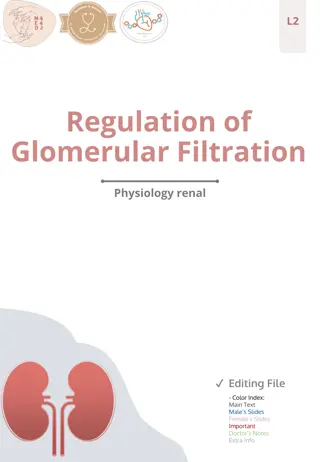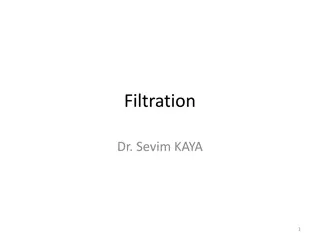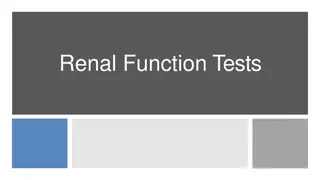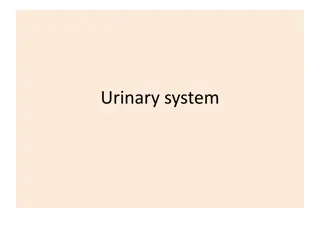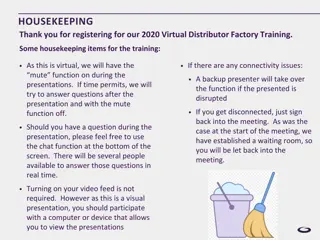Processes of Blood Cleaning by the Kidneys: Glomerular Filtration and Tubular Reabsorption
The kidneys perform vital processes to filter blood, including glomerular filtration and tubular reabsorption. Learn how these processes work and the importance of regulating the glomerular filtration rate. Explore the intricate mechanisms involved in maintaining blood health through kidney function.
Download Presentation

Please find below an Image/Link to download the presentation.
The content on the website is provided AS IS for your information and personal use only. It may not be sold, licensed, or shared on other websites without obtaining consent from the author.If you encounter any issues during the download, it is possible that the publisher has removed the file from their server.
You are allowed to download the files provided on this website for personal or commercial use, subject to the condition that they are used lawfully. All files are the property of their respective owners.
The content on the website is provided AS IS for your information and personal use only. It may not be sold, licensed, or shared on other websites without obtaining consent from the author.
E N D
Presentation Transcript
Blood Cleaning by the Kidneys The processes performed by the kidneys in order to filter (clean) blood. are: Glomerular Filtration also called "Ultra-filtration", Tubular Reabsorption also called "Selective Re- Absorption" and Tubular Secretion.
Glumerular filtration rate: The fluid that enters the glomerular capsule is called ultrafiltrate because it is formed under pressure the hydrostatic pressure of the blood. Also, since the protein concentration of the tubular fluid is low(less than 2 to 5 mg per 100 ml) compared to that of plasma (6to 8 g per 100 ml),
Because glomerular capillaries are extremely permeable and have an extensive surface area, this modest net filtration pressure produces an extraordinarily large volume of filtrate. The glomerular filtration rate (GFR) is the volume of filtrate produced by both kidneys per minute. The GFR averages 115 ml per minute in women and 125 ml per minute in men. This is equivalent to 7.5 L per hour or 180 L per day (about 45 gallons)! Since the total blood volume averages about 5.5 L, this means that the total blood volume is filtered into the urinary tubules every 40 minutes. Most of the filtered water must immediately to the vascular system, or a person would literally urinate to death within minutes. obviously be returned
The diameter of the afferent (incoming) arteriole is greater than the diameter of the efferent arteriole (by which blood leaves the glomerulus). The pressure of the blood inside the glomerulus is increased due to the difference in diameter of the incoming and out-going arterioles. This increased blood pressure helps to force the following components of the blood out of the glomerular capillaries:
Most of the water;Most of the salts;Most or all of the glucose;Most or all of the urea. The above are filtered in preference to other components of blood based on particle size. (Water and solutes of relative molecular mass less than 68,000 form the filtrate.) Blood cells and plasma proteins are not filtered through the glomerular capillaries because they are relatively larger in physical size. The glomerular filtrate passes from the renal corpuscle to the renal tubule.
Regulation of Glomerular Filtration Rate: Vasoconstriction or dilation of afferent arterioles affects the rate of blood flow to the glomerulus, and thus affects the glomerular filtration rate. Changes in the diameter of the afferent arterioles result from both extrinsic regulatory mechanisms (produced by sympathetic nerve innervation), and intrinsic regulatory mechanisms (those within the kidneys, also termed renal autoregulation). These mechanisms are needed to ensure that the GFR will be high enough to allow the kidneys to eliminate wastes and regulate blood pressure, but not so high as to cause excessive water loss.
Sympathetic Nerve Effects An increase in sympathetic nerve activity, as occurs during the fight-or-flight reaction and exercise, stimulates constriction of afferent arterioles. This helps to preserve blood volume and to divert blood to the muscles and heart. A similar effect occurs during cardiovascular shock, when sympathetic nerve activity stimulates vasoconstriction. The decreased GFR and the resulting decreased rate of urine formation help to compensate for the rapid drop of blood pressure under these circumstances
Renal Autoregulation The ability of the kidneys to maintain a relatively constant GFR in the face of fluctuating blood pressures is called renal autoregulation. Renal autoregulation is achieved through the effects of locally produced chemicals on the afferent arterioles (effects on the efferent arterioles are believed to be of secondary importance).When systemic arterial pressure falls toward a mean of 70 mmHg, the afferent arterioles dilate, and when the pressure rises, the afferent arterioles constrict. Blood flow to the glomeruli and GFR can thus remain relatively constant within the autoregulatory range of blood pressure values.
Autoregulation is also achieved through a negative feedback relationship between the afferent arterioles and the volume of fluid in the filtrate. An increased flow of filtrate is sensed by a special group of cells called the macula densa in the thick portion of the ascending limb When the macula densa senses an increased flow of filtrate, it signals the afferent arterioles to constrict. This lowers the GFR, thereby decreasing the formation of filtrate in a process called tubuloglomerular feedback.



